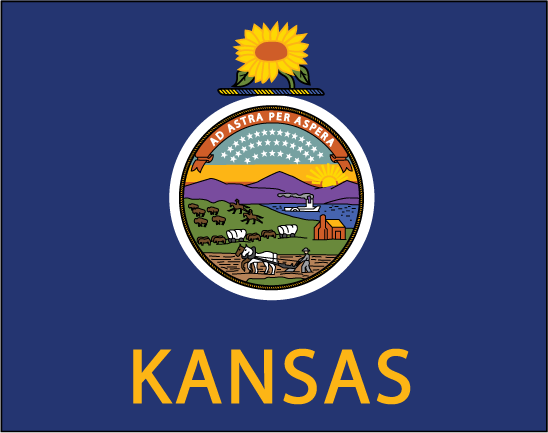During 1937 about 228,000 part and fulltime industrial workers were employed in Kansas. Of this number an average of 44,000 were employed in trade, 42,000 in manufacturing, 38,000 in transportation, 19,000 in mining and quarrying, 12,000 in service industries, and 11,000 in communication and utilities. The average annual wage in the foregoing industries amounted to $1,233.05.
Kansas industry was, until the second decade of the present century, operated largely on the open shop plan. In the period after the Civil War most of the trade unions in the State reflected the general conditions of the country as a whole, and were mainly local organizations. The formation of national unions was slow.
When the depression of 1873 swept over the country, prices and profits plunged downward. Employers began a tremendous drive to lower wages, which in turn brought about a stiffer resistance on the part of the workers. Labor fought back with the only weapon it had, the strike. This period, therefore, was one of many bitter strikes, among which those of the railroad workers in 1877 were the most outstanding.
The first strike in Kansas occurred in 1877 when employees of the Santa Fe Railway joined a Nation-wide walkout to obtain higher wages. The railroad shops at Topeka, Emporia, and Lawrence were peacefully picketed, but Governor George T. Anthony immediately dispatched militia companies to those cities. The citizens of Emporia termed the use of troops an insult to their persons and their city. The militia was thoroughly discredited when one of their members accidentally shot and killed the Reverend O. J. Shannon, an Emporia minister. Governor Anthony subsequently withdrew the troops and the strike was settled without further disorder.
The first legislation designed to benefit Kansas industrial workers was enacted during the term of Governor John A. Martin (1885-89). The Governor was a member of a typographical union and in sympathy with the general policy of the Knights of Labor, which occupied an outstanding position in the labor movement of that period. In the first year of his governorship the legislature created a bureau of labor and industrial statistics, the establishment of which had been advocated in 1884 by the General Assembly of the Knights of Labor. The same legislature also passed a bill requiring the wage of industrial workers to be paid monthly in "lawful money of the United States." Near the close of the session, however, this bill was all but abrogated by an amendment sponsored by groups that feared to place any restraint on the industrial development of the State.
Two months after Governor Martin had been inaugurated, railroad shop workers at Parsons and Atchison walked out in response to a strike called in Missouri, Kansas, and Texas to resist wage reductions and increased hours proposed by the Missouri Pacific Railway. The railroad officials immediately telegraphed for troops to guard company property. After a survey of the strikers' picketing methods Governor Martin refused to send the militia, noting, incidentally, that the legal right of a railroad official to request the use of troops had not been established by any Kansas statute.
Governor Martin twice proposed that the strike be arbitrated by a disinterested committee; officials of the railroad company twice declined. On March 13, 1885, however, H. M. Hoxie, vice-president of the Missouri Pacific Railway, asked Governor Martin to confer at St. Louis, Missouri, with the board of railroad commissioners, the Governor of Missouri, and a representative of the railroad company. The Governor promptly assented. The company granted the demands of the workers and the strike ended.
The snags encountered in mediating the railroad strike impelled Governor Martin to propose the creation of legal machinery to expedite the settlement of future industrial disputes. At a special session in January 1886 he asked the legislature to establish a tribunal of voluntary arbitration. A bill was accordingly passed on February 18, empowering the district county courts, upon the petition of employer or employee, to set up a court of voluntary arbitration over which an umpire appointed by the district judge would preside.

